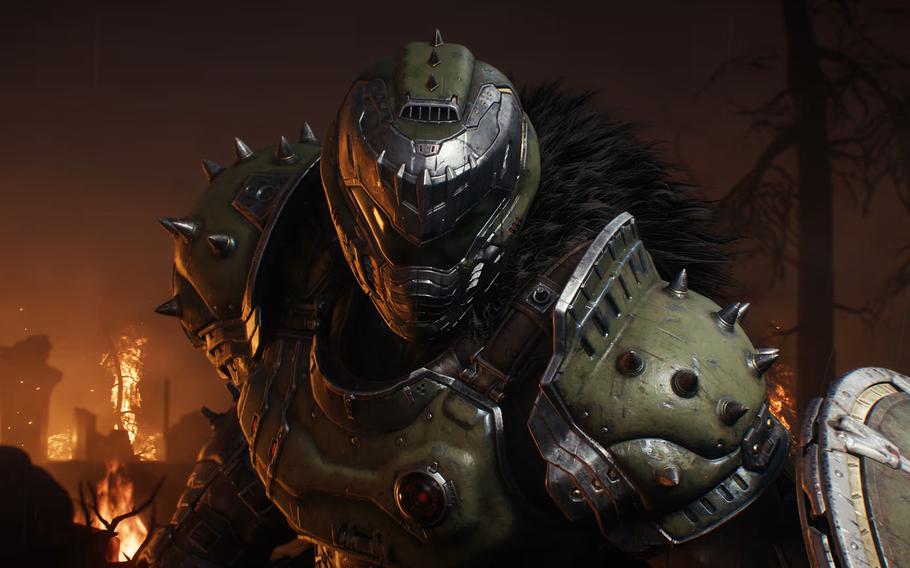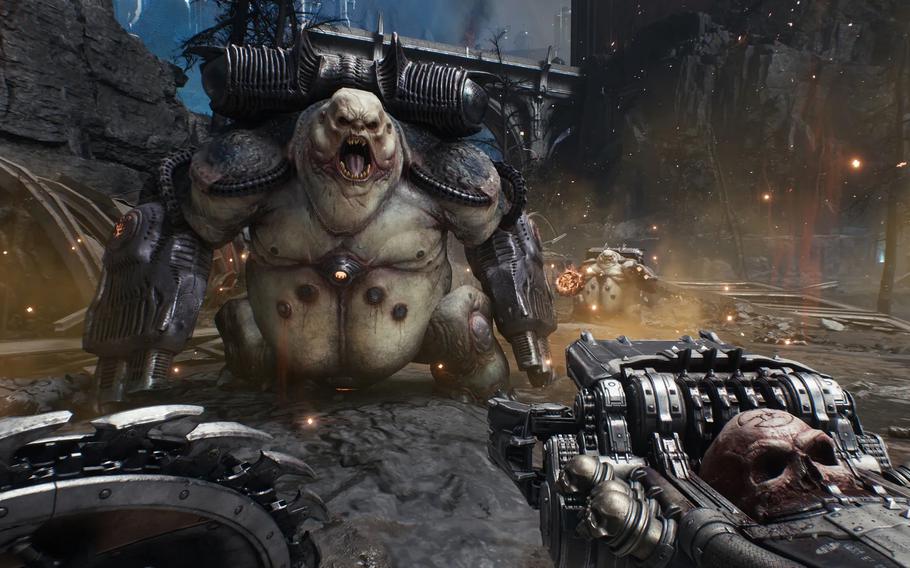
Doom: The Dark Ages chronicles the ancient history of the Doom Guy, the iconic and founding character of first-person shooting games. (Xbox Game Studios)
Doom is one of the few titles that can stand alongside Mario and Tetris as one of the most important video games ever - first thanks to the classic series that started in 1993, and then with the reboot series (beginning in 2016) that has been heralded as among the finest in the first-person shooting genre.
The long shadow cast by the franchise nearly overwhelms the latest in the series, Doom: The Dark Ages, the story of how one man became the bane of hell and its demons. (It’s also the name of a track by composer Mick Gordon, whose industrial-metal scores helped define the modern identity of the series. Production company Finishing Move takes over the score from Gordon in this installment.)
But fortunately, The Dark Ages stands out when it comes to the important part: ripping and tearing apart demons as a one-man juggernaut. It’s easily the best first-person action game since 2016. The action is thoughtfully remixed, a balance between the free-form player expression of games like the Devil May Cry series and the swap-and-drop strategy of the 2020 sequel Doom Eternal.
This latest installment from id Software chronicles the ancient history of the series’ hero, the Doom Guy, although here he’s called by his mythical warrior title, Doom Slayer. The modern Doom series created time travel and multiverse shenanigans to transport the space Marine from the 1993 game to new settings. Plot contrivances in Doom Eternal allowed him to become a knighted warrior of an ancient world that was meant to evoke the Christian heaven. This silly premise worked best when it focused on pulling the right emotional triggers (the better to send us off on a demon-killing rampage). Dark Ages thankfully remembers this, dotting a largely nonsensical story of angels and demons with the right scenarios to incite the Slayer into feats of fury.
The point is the combat, and Dark Ages arms the Slayer with a shield that is the foundation of a new battle flow in which defense is the best offense. Guarding and parrying against the swarms of bullets means reflecting damage back against the demon horde - which feels like it addresses the stop-and-react criticisms Eternal faced. Game director Hugo Martin has likened this version of Slayer to an “iron tank,” but I disagree. This Slayer is closer to a bullet out of hell, flying and flailing around like the new and satisfying ball-and-chain weapons introduced to his kit.
Thanks to this system, I was doing three-hit punch combos against enemies in the air before slamming into the ground with my shield to splatter half a dozen demons. I would then parry an attack that splats another creature before tossing my shield through a line of demons and putting a shotgun into the face of another. The game lacks the signature “glory kills” of the past two games, and as visceral pauses in the action, they’re missed. But the new focus on melee combo strings might make up for it. You’ll certainly feel that way as your punches rip apart demon bodies.

A gun that shoots out skull fragments as bullets is just one of the inventive new weapons in Doom: The Dark Ages. (Xbox Game Studios)
Dark Ages also introduces vehicular combat that changes up the pace. The titanic robot fights are fun rock-’em, sock-’em diversions, but they move too smoothly in an attempt to re-create the game’s ground speed. The dragon levels can also be hit or miss, at least in the early going, but later battles create high-speed chase scenarios with dragons dashing in and out of canyons of dark-fantasy skyscrapers.
Finishing Move scored Dark Ages, and while the music stays true to the overall spirit of the series (the thrash metal is appropriately rip-roaring), it’s hardly experience-defining stuff, as Gordon’s scores were. On tracks like “The Only Thing They Fear is You,” Gordon composed like an industrial Prince, with funky melody lines and an uncanny sense of rhythm set against those caterwauling metal riffs, palm-muted strings and pounding beats. It felt in sync with the violence of the game, whereas Finishing Move’s thrash sounds more conventional. Sadly, id Software and Gordon publicly clashed over contracts, payment and creative control, leaving their latest hellscape with a less distinctive soundscape.
At least the game’s gothic environments - castles, fiendish forests - stay rich. And Dark Ages pulls back from the platforming sequences that felt ill-advised in Eternal. Now, Slayer just clambers up walls automatically.
The scenarios could’ve been more interesting. The open battlefields of Dark Ages are the biggest ever in the series, evoking fond memories of Halo 3, when first-person games attempted to re-create realistic large-scale battles. But even with the latest tech, these battles feel small and suggestive. Titans punch each other in the distance, but the Slayer can’t interact with any of those fights. These large battlefields suggest armies clashing, but it’s really just you against a demon horde. It may sound like I want this to be a different game, but even the 1993 debut had scenes of monster infighting.
So I’m left wishing, in part, that this foundational franchise could finally make good on its earliest aspirations. But all of these concerns melt away when I’m in the thrall of Dark Ages’ perfectly balanced first-person action system. To be designed as tightly and soundly as the seminal 2016 reboot is still a resounding success. Even without Gordon, Dark Ages moves like a groovy, filthy bass line, transporting us to a world where, whatever your frustrations are, at least there are endless faceless demons to hound and pound.
Platforms: PC, PlayStation 5, Xbox Series X/S